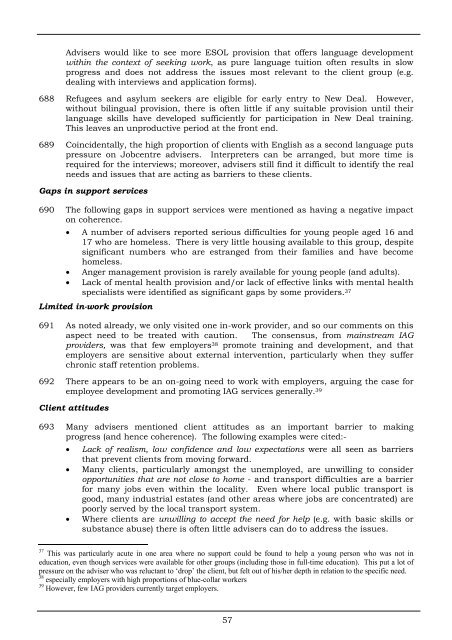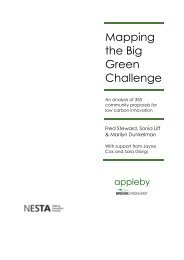Client needs for coherent information, advice and guidance services ...
Client needs for coherent information, advice and guidance services ...
Client needs for coherent information, advice and guidance services ...
You also want an ePaper? Increase the reach of your titles
YUMPU automatically turns print PDFs into web optimized ePapers that Google loves.
Advisers would like to see more ESOL provision that offers language development<br />
within the context of seeking work, as pure language tuition often results in slow<br />
progress <strong>and</strong> does not address the issues most relevant to the client group (e.g.<br />
dealing with interviews <strong>and</strong> application <strong>for</strong>ms).<br />
688 Refugees <strong>and</strong> asylum seekers are eligible <strong>for</strong> early entry to New Deal. However,<br />
without bilingual provision, there is often little if any suitable provision until their<br />
language skills have developed sufficiently <strong>for</strong> participation in New Deal training.<br />
This leaves an unproductive period at the front end.<br />
689 Coincidentally, the high proportion of clients with English as a second language puts<br />
pressure on Jobcentre advisers. Interpreters can be arranged, but more time is<br />
required <strong>for</strong> the interviews; moreover, advisers still find it difficult to identify the real<br />
<strong>needs</strong> <strong>and</strong> issues that are acting as barriers to these clients.<br />
Gaps in support <strong>services</strong><br />
690 The following gaps in support <strong>services</strong> were mentioned as having a negative impact<br />
on coherence.<br />
• A number of advisers reported serious difficulties <strong>for</strong> young people aged 16 <strong>and</strong><br />
17 who are homeless. There is very little housing available to this group, despite<br />
significant numbers who are estranged from their families <strong>and</strong> have become<br />
homeless.<br />
• Anger management provision is rarely available <strong>for</strong> young people (<strong>and</strong> adults).<br />
• Lack of mental health provision <strong>and</strong>/or lack of effective links with mental health<br />
specialists were identified as significant gaps by some providers. 37<br />
Limited in-work provision<br />
691 As noted already, we only visited one in-work provider, <strong>and</strong> so our comments on this<br />
aspect need to be treated with caution. The consensus, from mainstream IAG<br />
providers, was that few employers 38 promote training <strong>and</strong> development, <strong>and</strong> that<br />
employers are sensitive about external intervention, particularly when they suffer<br />
chronic staff retention problems.<br />
692 There appears to be an on-going need to work with employers, arguing the case <strong>for</strong><br />
employee development <strong>and</strong> promoting IAG <strong>services</strong> generally. 39<br />
<strong>Client</strong> attitudes<br />
693 Many advisers mentioned client attitudes as an important barrier to making<br />
progress (<strong>and</strong> hence coherence). The following examples were cited:-<br />
• Lack of realism, low confidence <strong>and</strong> low expectations were all seen as barriers<br />
that prevent clients from moving <strong>for</strong>ward.<br />
• Many clients, particularly amongst the unemployed, are unwilling to consider<br />
opportunities that are not close to home - <strong>and</strong> transport difficulties are a barrier<br />
<strong>for</strong> many jobs even within the locality. Even where local public transport is<br />
good, many industrial estates (<strong>and</strong> other areas where jobs are concentrated) are<br />
poorly served by the local transport system.<br />
• Where clients are unwilling to accept the need <strong>for</strong> help (e.g. with basic skills or<br />
substance abuse) there is often little advisers can do to address the issues.<br />
37 This was particularly acute in one area where no support could be found to help a young person who was not in<br />
education, even though <strong>services</strong> were available <strong>for</strong> other groups (including those in full-time education). This put a lot of<br />
pressure on the adviser who was reluctant to ‘drop’ the client, but felt out of his/her depth in relation to the specific need.<br />
38 especially employers with high proportions of blue-collar workers<br />
39 However, few IAG providers currently target employers.<br />
57











